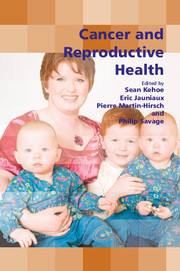Book contents
- Frontmatter
- Contents
- Participants
- Preface
- SECTION 1 Epidemiology, Genetics and Basic Principles of Chemotherapy and Radiotherapy
- SECTION 2 Fertility Issues and Paediatric Cancers
- 5 Assisted reproductive technology for preserving fertility in women with cancer
- 6 Fertility after cancer therapy
- 7 Fertility-preserving surgery in women with cancer of the cervix
- 8 Gonadal function and fertility issues in children and young people treated for cancer
- SECTION 3 Gynaecological Cancers and Precancer
- SECTION 4 Diagnostic Dilemmas
- SECTION 5 The Placenta
- SECTION 6 Non-Gynaecological Cancers
- SECTION 7 Multidisciplinary Care and Service Provision
- SECTION 8 Consensus Views
- Index
5 - Assisted reproductive technology for preserving fertility in women with cancer
from SECTION 2 - Fertility Issues and Paediatric Cancers
Published online by Cambridge University Press: 05 October 2014
- Frontmatter
- Contents
- Participants
- Preface
- SECTION 1 Epidemiology, Genetics and Basic Principles of Chemotherapy and Radiotherapy
- SECTION 2 Fertility Issues and Paediatric Cancers
- 5 Assisted reproductive technology for preserving fertility in women with cancer
- 6 Fertility after cancer therapy
- 7 Fertility-preserving surgery in women with cancer of the cervix
- 8 Gonadal function and fertility issues in children and young people treated for cancer
- SECTION 3 Gynaecological Cancers and Precancer
- SECTION 4 Diagnostic Dilemmas
- SECTION 5 The Placenta
- SECTION 6 Non-Gynaecological Cancers
- SECTION 7 Multidisciplinary Care and Service Provision
- SECTION 8 Consensus Views
- Index
Summary
Keywords
- Type
- Chapter
- Information
- Cancer and Reproductive Health , pp. 63 - 72Publisher: Cambridge University PressPrint publication year: 2008



